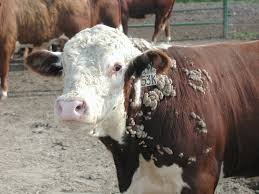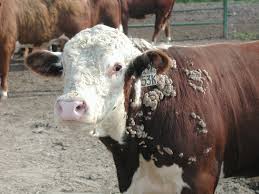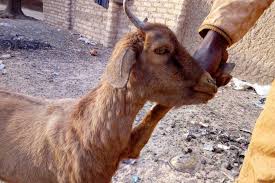Health care is the management of the well-being of animals including the diseases of ruminants to ensure normal metabolic and physiological processes in its system. Any situation where by an animal deviates from the normal functioning system is referred to as a disease condition.
The abnormal or change in the physiological system is often brought about by micro-organisms called pathogens.
These pathogens could be bacteria, virus or fungi. When animals are in any disease condition, the production efficiency becomes low and in some cases may terminate the life of the animal with a consequential economic loss to the farmer. We shall discuss some few but important ones.
1. Infectious Diseases of Cattle

a) Contagious Bovine Pleuro-pneumonia (CBPP)
This is a disease that infects the lungs of cattle. It is caused by Mycoplasma mycoides. It is very prevalent in the West African region and other arid and semi-arid zones.
The symptoms of the disease include rapid and labored breathing associated with cough, anorexia, fever, dry and hard coat. The infected animal will be very reluctant to move and often lag behind others.
The animal may die within few days to a week of infection. More than half of the infected animal may die within this short period. Survivals are always carriers of the disease.
Infection of other animals is possible through inhalation of the droplets from the nasal discharge of infected animal.
Treatment of CBPP is very rare and in endemic cases tylosin may be used. A veterinarian must be invited for this operation.
The disease is controlled by vaccination with attenuated vaccine given at the tip of the tail.
The vaccine can last 12 months. Because the disease is spread by contact and inhalation of droplets from nasal discharge, the infected animals must be separated from the others for housing, during mass movement for feeding and to the market.
There must be quarantine programme for such animals. The disease is also controlled by slaughter policy.
b) Haemorhagic Septicaemia
This disease is caused by bacterial infection of Pasteurella multocida. It is noticed by symptoms such as dullness, fever, excessive salivation, reluctance to walk, nasal discharge, difficulty in repiration and oedema around the neck region.
Infected animal dies within two or three days of infection. Infection is through nasal discharge, salivation and faeces.
Animals can be treated with oxytetracycline if quickly discovered. It can also be controlled by yearly vaccination.
c) Actinomycosis or Bovine Farcy
They are caused by Mycobacterium farcinogen with observable signs of small lumps or nodules seen under the skin, the shoulders and the limbs. The lumps develop and spread slowly to all other part of the body.
Over- time the disease may affect internal organs. Contamination of the skin wounds from tick bites or thorrns during grazing. It is a very difficult disease to treat. Therefore, separation and quarantine of the infected animal is advised.
Effect on animal is not often very pronounced except for the unsightly skin but they could come down with tuberculosis.
d) Brucellosis
The causative agent is Brucella abortus. It has incubation period of few days to month and infect the uterus and foetal membrane thereby causing abortion. It is a disease that affect both man and animals.
It can be passed readily from the lactating animal through its milk or aborted afterbirth. Brucellosis is also spread through contaminated water, food, skin, eye, nostril or by licking the hind-quarter of infected animal by another cattle.
There is no `effective treatment but the animal could be immunized. Other control measure apart from immunisation is to completely destroy any herd where it is detected.
e) Foot and Mouth Disease
It affects cloven footed animals. The symptoms are high fever, blisters around the mouth, udder, teats, hooves and toes resulting to lameness.

It spread through direct contact with infected animals or through their manure, forages, water and the attendants on the farm. It is a viral disease.
There is no effective treatment but once detected in any herd, the farm must be isolated and the whole stock should be slaughtered.
f) Anthrax
It is an acute disease of cattle, sheep, goats and sometimes man. The causative agent is Bacillus antharacis. It is incubated within one to two weeks after which may be followed by short illness characterised by fever, laboured breathing, convulsion and sudden death.
Discharge of thick black blood comes from the external orifices such as the mouth, nostrils, anus and vulva. If quickly discovered, anthrax can be treated with the administration of antibiotics such as penicillin and oxytetracycline. It can be controlled by burning and burying the carcass of infected animals.
Veterinarian must be contacted the moment the disease is detected on the farm.
Read Also : External Parasites of Ruminant Animals
g) Tuberculosis
This is a bacterial infection caused by Mycobacterium bovis. Symptoms include, emaciated body, dry husky cough with the infection of the lungs. The disease is confirmed by carrying out the tuberculin test and treated by vaccination.
The disease is transmitted through exhaled air, nasal discharge, saliva, faeces, urine and milk.
h) Mastitis
It is a disease caused by Staphylococcus,Streptococcussppand Corynebacterium Pyogenes with the inflammation of the quarters of the udder tissue which becomes at times distended.
The causative agent is excreted in the milk and with time the milk is tainted with blood and pus. It causes the infected animal severe pain. The infected tissue becomes fibrous ranging from a few nodules to extensive hardening.
It is often detected by experience stockman by palpation of the udder and identifying the hard tissue. In severe cases abscesses or gangrene may develop in the affected part.
Infected animal is treated by first stripping out the milk by hand, wash thoroughly the infected quarter and infused with antibiotic. Repeat regularly for every 12 hours until improvement is noted. Milk from the animal during this period must be discarded.
Strict hygiene is one of the best control measures with regular screening of the milk to identify the infected animals.
2. Infectious Disease of Sheep and Goats
a) Contagious Caprine Pleuro-pneumonia(CCPP)
This disease infects the lungs of goats. It is caused by Mycoplasmastrains of bacteria. Symptoms of the disease include, fever, nasal discharge, laboured breathing with coughing, pneumonia and inflammation of the chest lining. All these lead to loss of condition. Other goats are infected by contact.
CCPP can be treated if quickly diagnosed with tylosin. It can be controlled by immediate separation of infected animals, slaughtering and vaccination. Over-crowding must be avoided especially overnight.
b) Footrot
It is a disease found both in cattle, sheep and goats affecting their feet as in cattle. It is caused by the same causative agent Fusobacteriumnecrophorum.
Symptoms include inability of the animal to walk, lameness, at times the animal squat to graze.
The animal may be first noticed with the reddening of the skin between the toes called “scald”. Infection spread through contaminated pasture especially during warm wet weather condition.
Treatment is embarked upon by first trimming the hooves and inserting the toes in bactericides e.g. 10% zinc or copper sulphate solution with or without detergent. It can be controlled by the use of foot bath.
c) OrforS or emouth
This is a viral infection of the skin and mucous membranes of sheep and goats. It starts with lesions that are wart-like clusters on the skin around the feet, teats of udder, and the mouth.
They develop as ulcer in the vulva. Infection is spread through suckling by the young ones. The effect of non-suckling by the young animal may cause mastitis in the dam.
It can be treated by injection of antibiotics. Standard sanitary procedure most be employed on the farm as control measure. Infected animal must be separated immediately.
d) Pestedes Petitis Ruminant (PPR)
This is a viral infection of goats and sometimes sheep. It is also called “kata”. It is noticed by a profuse nasal discharge of mucus accompanied with high fever and diarrhea.
The animal looses appetite and does not eat. It is depressed with reddened eyes and lining of the nose and mouth with watery discharge. The animal may die within one week of infection.
The disease spread through the placenta of an infected animal and sometime the pasture. There is no known treatment for PPR. Animals that survived always get immuned. Animal may be protected by vaccination with rinderpest vaccine.
e) Sheep and Goat Pox

It is a viral infection with lesions on the skin and internal organs of the infected animal. In addition to the above, symptoms include, fever, discharge from the nose and eye, red spot over the skin, lining of the mouth, nose and the vula. The animal gets irritated and rubs its body. It leads to abortion in some animals.
There is no treatment but can be controlled by strict observance of hygiene and at times vaccination.
3. General Diseases
a) Bloat
This is a disease that shows with the distension of the rumen as a result of it being filled with gas. It appears at the left hand side of the abdomen behind the ribs and become swollen with a stretched skin coat that gives a sound when tapped with hands like a drum.
It is characterized with distressed posture at times with bleating, difficult breathing and the animal may die instantly if unattended to. It is mostly caused by feeding of wet forage.
It implies from the above that to control or prevent bloat, the animal must not be given wet fresh forage rather it should be wilted. It can be treated if quickly diagnosed (because inexperience stockman may not be able to notice this) by drenching with vegetable oils or any anti-foaming agent e.g. soya oil, palm oil, etc.
In summary, below is the summary of what you have learnt in this article:
Disease is an abnormal metabolic and physiological functioning of the animal. Diseases such as contagious bovine pleuropneumonia (CBPP), bovine farcy etc. are infectious diseases of cattle.
CCPP, foot rot, orf, PPR are also infectious diseases of sheep and goats. Cattle, sheep and goats have general or common diseases such as anthrax, brucellosis, foot and mouth disease etc. Disease brings about economic loss in ruminant animal production.
Read Also : Impact of Agricultural Wastes on Human and Environment
